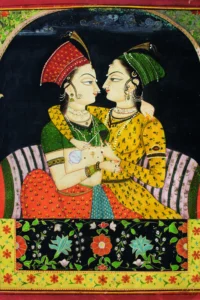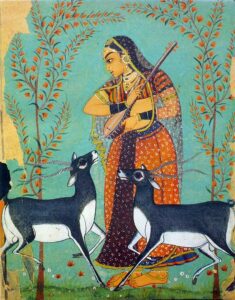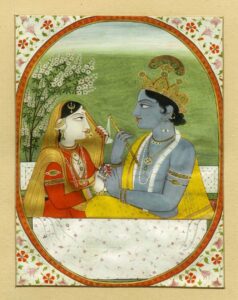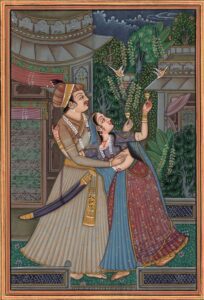Indian miniature painting
Indian miniature painting has a long history of miniature art, which is renowned for its fine brushwork, vivid colors, and minute details.
This art form, which has its roots in the Middle Ages, was very popular in Rajasthan, the Mughal courts, and the Pahari kingdoms. Usually tiny in size but brimming with detail, Indian miniature painting frequently features scenes from nature, mythology, and royal courts. These works of art are created by artists using natural pigments and fine brushes, which are frequently made from squirrel hair.

Indian miniature painting. These works of art are created by artists using natural colors and delicate brushes, which are frequently fashioned from squirrel hair. The paintings are distinguished by their accuracy, with each component—from the ornate clothing and jewelry to the expressive expressions of the figures—carefully depicted. Every area has its own unique style, Rajput Indian miniature painting.

are more colorful and symbolic, while Mughal miniatures are renowned for their realism and Persian influences. This artistic medium, which embodies a synthesis of different elements, has never failed to enthrall art enthusiasts with its classic beauty and skill.
Indian Paintings
Miniature Art
“Miniature” The word miniature is derived from the Latin word minimum which means red colored glass. This color was used in illuminated manuscripts during the Renaissance period. Pictures should not be larger than 25 square yards

Miniature Picture
The picture of Vinay should be painted more than 1/6 of the actual size.
Preliminary Indian miniature painting
Indian miniature painting. small paintings, with fine details used to be. Including paper, palm leaves and clothes on destroyed materials, books or albums painted for used to go. Developed almost as a response to large wall paintings, miniature painting developed between the 8th and 12th centuries.
There are two major types:
Pal style of art.
Avant-garde style of art.
Pal style of art
This style was developed during 750 to 1150 AD. The drawings are found as part of manuscripts. They are made on palm-leaf or parchment
Buddhist monks used these and, in their religion, all living beings were treated with non-violence
Banana or coconut tree leaves were also used for art. The paintings mostly have lonely figures and group chits are found.
Their composition is simple, and they were patronized by some rulers who promoted Bodh Dharam were two prominent painters named Dhiman and Vita pal.
Apricot style of art
This style is native to the Mewar region of Gujarat and Rajasthan. It was the dominant Western Indian painting style from the eleventh century to the 15th century.
He brought into this Indian miniature painting the concept of Gita Govinda and secular love which was otherwise dominated by Jain scriptures. In the early Jain phase, the paintings were made on palm stone, but later they were also made on paper, this did not develop a different style, rather it was afraid of low- graffiti. Therafuse. Indian miniature painting the colors used in these paintings had symbolic meaning and used red, yellow and ochre colors.
In the later stages, they used bright and gold colors, the human figure depicted in these paintings was characterized by fish-shaped bulging eyes, sharp nose, and double chin. An attempt was also made to start the trend of making thin faces of third and fourth profiles. Indian miniature painting depicts the figures of animals and birds as toys, the most famous examples being that of the 15th-century Kalpasutra and Kalakacharya Katha.
Transition Miniatures Indian miniature painting
The arrival of Muslims in the Indian subcontinent was a harbinger of change, and they brought about a cultural renaissance in the fourteenth century. The tradition of painting survived in the southern kingdom of Vijayanagar, a distinct style was emerging which was close to the Dankani style of painting, colors were decorated in a flat manner and the motifs were inscribed in black in the Western Indian courts.
Indian miniature painting in Delhi Sultanate
These paintings attempted to bring together Persian elements of their origin with Indian traditional elements. One of the best examples of this period is a book on Nimatnama during the reign of Nasir Shah who ruled Mandu.
This manuscript shows the synthesis of indigenous and Persian styles. Another style called Lodhi Khula Dar was prevalent during this period. It was followed in several Sultanate granting areas between Delhi and Jaunpur.
Indian miniature painting of Mughal period
This was the typical style of paintings made during the Mughal period, these were taken from the pre-Persia vows. The apparition of colors was altered in themes and forms, instead of depicting this class, it was to glorify the ruler. Historical events and other paintings related to the court were focused on Mughal painting being a mixture of the affluence of the great dynasty and Persian naturalistic style.

In which some beautifully illustrated pages were created. Due to the use of bright colors, these paintings are considered A II, except for religious paintings, the Mughals are known for their diverse subjects. Even though he made only miniatures, these paintings are still considered among the most unique paintings in the world.
Early Mughal painter
Babur, a Persian artist, is also said to be the protector of Bihzad. Humayun, the great patron of the arts, ascended the throne at an early age. During this time, he was in the court of Shah Tahmasp in Persia, he obtained the services of two main painters, Abdus Samad and Mir Saeed Ali.
When he won back his throne and established the Mughal dynasty in India, these two came back with him. During Akbar’s breath period, he prepared a picture manuscript called Tutinama.
Akbar
Akbar is credited with establishing an entire department devoted to Indian miniature painting and calligraphy of his documents. She founded a formal artistic studio called Picture Food. Akbar saw painting as a means of study and entertainment, he regularly gave awards to painters who made Sanjiv paintings. He also recognized the beauty of Indian artists.

Indian influence began to come in Mughal painting. Artists were encouraged to use calligraphy. The artists were more focused on depicting court life than the life of the common people. The famous painters of this period were Dashwant Basavan and Keshu. The principal secretaries of Akbar’s reign were TutiNaMa Hamzanama, Anwar- e -Suhaili and Gulistan of the century.
Jahangir
Mughal Indian miniature painting reached its height during the reign of Jahangir. He was naturalistic by nature. he preferred paintings of birds, animals, trees and flowers. She insisted on bringing naturalism to the image and transferred from illustrated manuscripts to albums.

Jahangir is also considered a good artist. he had her own private workshop, no major creation of her left now. His gallery mostly produced miniature paintings, the most famous of which were the zebras and natural paintings of roosters and saturfowls. Ustad Mansoor was expert in creating even the most complex facial shapes. The animal book named Ayar -e-Danish was written during his reign.
Shahjahan
Shah Jahan preferred artificial elements, he tried to reduce the liveliness. Encouraged drawing using pencils encouraged. Mughal art expanded during his period.

Aurangzeb
Aurangzeb did not encourage painting, the provincial courts began to migrate, their activity declined sharply.

conclusion
In summary, Indian miniature painting combines fine workmanship with cultural storytelling to showcase the nation’s rich artistic legacy. These paintings, in spite of their little size, tell significant tales and remarkably accurately capture the spirit of Indian mythology, history, and everyday life.
The painters’ talent and commitment are evident in every brushstroke, upholding age-old customs. As a lively connection to India’s artistic history and a source of inspiration for both modern artists and art fans, miniature paintings are still appreciated today for their aesthetic appeal and historical value.
